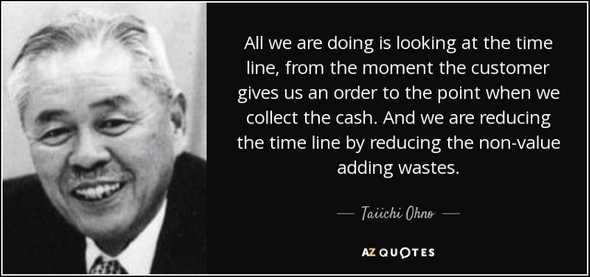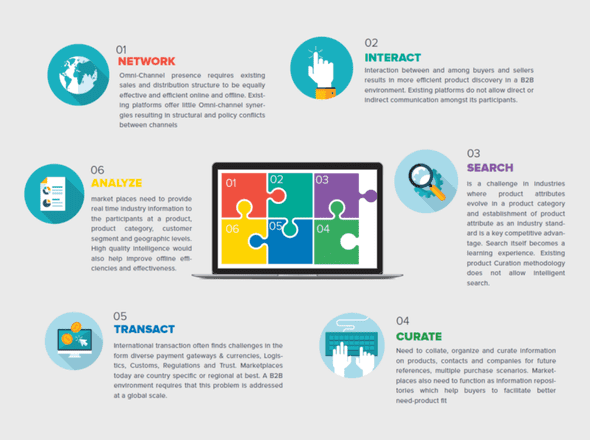Taking the medical device industry DIGITAL
December 22, 2016
Operations had been my favorite stream during MBA days. That was the only stream which allowed us to remove all bells and whistles and look at a problem in two dimensions — time and money.
One book which deeply influenced me in my consulting career is “The Toyota Way” by Jeff Liker. The above quote by Taiichi Ohno, the father of lean manufacturing struck me the most. The quote formed the basis of the famed Toyota Production System. The underlying question on the journey to the Toyota Way starts with the customer.
“What value are we adding from the customer’s perspective. Because the only thing which adds value in any type of process — be it manufacturing, marketing, or a development process is the physical or information transformation of that product, service or activity into something which the customer wants.”
Market Fragmentation
Medical device industry faces enormous challenges particularly due to the fragmented structure of its markets owing to regulatory setup, affordability and heterogeneous structure of healthcare systems across various countries and even states.
Not an impulse buy
Highly technical nature of products (irrespective of product category and price band) requires the sales and marketing personnel to grasp both the technical and application aspects of the products they sell. This results in a highly people dependent mode of sales and marketing. The challenge therefore is getting enough people to ensure effective market coverage.
Not just about making the sale
Traditionally the medical device industry has followed a distribution intensive approach to ensure product communication, training, installation and service support to last mile customers. Distributors have been and will remain an irreplaceable part of the market and distribution strategy puzzle of the medical device industry.
The industry will continue to lag behind other industries in terms of achieving global product roll-outs, uniformity in product life cycles, uniform product offerings / pricing across the globe and achieving higher service levels for their products. Doing so would naturally bring down the product costs and reduce risk.
While established companies (top 30) have been able to bridge the presence gap across the globe in terms of having a sales and service structure, there still exist huge gaps in terms of range of products and services offered across the globe.
While developing countries are seeing a rapid growth in private hospitals and healthcare chains, the vast population are still serviced by smaller hospitals and clinics in rural / semi-urban areas. It would not be economically feasible to have a sales / distribution coverage in these areas.
The need for an end to end market network
If we were to analyze the medical device industry purely from information flow (marketing, sales, product information, customer engagement, post purchase feedback), we can see that it is no where close to being “The Toyota Way”. This is because information flow to customers (read doctors, nurses, biomedical, purchase departments and patients) has been structured to flow as per the traditional norms and is highly physical in nature in terms of brochures, hand outs, training, seminars, demos etc. The ability of the companies to engage with their customers is at a nascent stage.
So how do companies target their customer chain — end users, influencers and decision makers? Patients, para-medical staff, doctors, biomedical department and purchase departments all play these inter-changeable roles based on the product category / therapy area. Leading medical device companies have products across therapy areas and and product categories. Sometimes, even products within a product category would have different roles being played by an individual in the decision making process. Medical device companies would have to tailor their marketing communication, sales strategy, ordering, supply, installation and after-sales through this complex web of roles.
To engage better with the customers medical device industry needs to go digital.
While majority of companies are looking at digital purely from product perspective in terms of IOT / data transfer capability / HIS compatibility etc, they are yet to look at this medium to effective network, interact and transact with their customers.
Digital today for many medical device companies means a facebook / LinkedIn / Google+ account with random posts or launching a dedicated mobile app. Website with a contact form still remains the only way by which a hospital or a clinic outside the distribution network can reach out to a company. Google search is still the most popular medium of product / brand discovery for medical devices.
All these have limitations and require investment of thousands of marketing dollars in SEO / SMO work. The ROI for this investment is low too because the target market for medical devices is very narrow and focused unlike consumer products where % of people who see the ad / search result and then engage with the ad/search result is higher.
Research has shown that doctors and paramedical staff are very poor consumers of digital content related to medical devices. Why do they see very little value in utilizing the digital medium? We have numerous articles and promotional material online on medical devices today. Can their impact on sales be measured? The answer is no. The reason is content delivery alone is not sufficient. Companies need to develop strategies to convert content into enquiries and enquiries into transactions.
If we see some online content promoting a laptop, mobile phone, pair of shoes or a book, we can immediately start to evaluate the product, visit online forums for reviews, get directed to an online store with which we can place an order, make a payment and track our shipment. Why can’t buying a medical device be so easy at least at a B2B level?
Unlike other products, medical device procurement shifts from online to offline due to the nature of the product. We lack the medium or a platform which provides continuity and allows the players to engage in offline activity (read demo, personal visit to detail and discuss the products / commercial aspects, installation) while maintaining an online thread to build networks, interact, curate information and transact.
Whatever digital content is directed at the customers today is very often not linked to the last-mile sales /marketing / service team members or distributors. People who are responsible to convert interest into sales. This means there is a lot of friction when the potential customers wish to discuss technical / pricing aspects on the product, request for a demo, place an order.
Moving from search to evaluation to purchase decision to transaction process is very painful in this industry in the current state.
The digital platform for medical devices
With Doctor’s Bazaar, we have designed the platform with six core guidelines (Network, Interact, Search, Curate, Transact and Analyze). What ever we do, whatever features we evaluate, we do so while considering the impact on these six guidelines.
With applications like the StoreFront and AssetManager we have enabled medical device companies to embrace ‘digital’ in their sales, marketing and distribution framework and hospitals to be more digital in their procurement and decision making process. The benefits also extend to managing the maintenance and service of existing assets by linking them to manufacturers on Doctor’s Bazaar.
Doctors Bazaar is an Enterprise platform for Medical Devices which performs Networking, Interaction and Marketplace functions. It aims to connect thousands of Medical Device Companies with millions of Hospitals, Clinics and Doctors around the world. Improving product discovery, product — therapy fit, global procurement and servicing solutions for Medical Devices. Try out the site at https://doctorsbazaar.com/
Doctor's Bazaar blog featuring announcements, updates and industry insights

